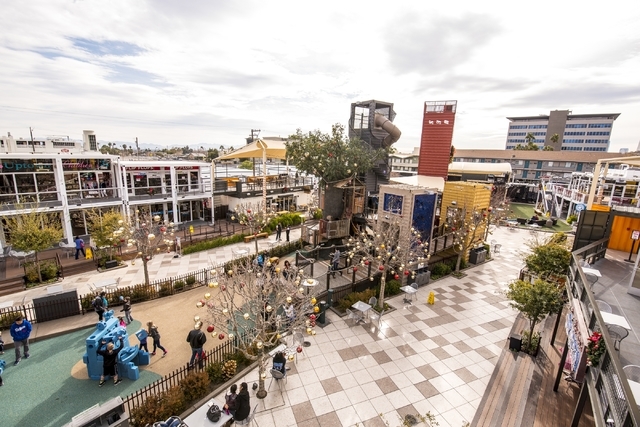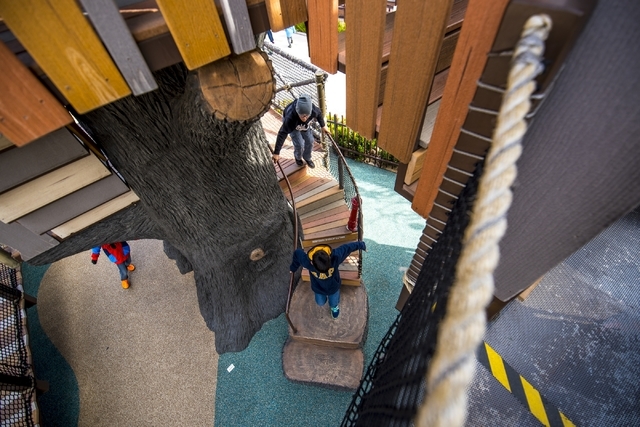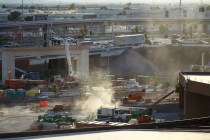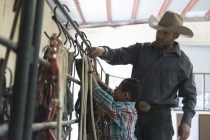Is Las Vegas a good place to raise a family?



Nationally, Las Vegas is known as the city of slot machines and 24-hour strip clubs. Billboards serve as a constant reminder of all “Sin City” has to offer. But venture off the Strip and beyond downtown, and you’ll find parts of the valley that resemble any other piece of suburban America. So, why do we get such a bad rap when it comes to raising families?
MORE THAN JUST THE STRIP
Due to its affordable housing and surplus of service jobs, Las Vegas has become an ideal place to live for many. But some argue that the city can have a negative impact on a child’s development. Most tourists see only what the Strip has to offer, and their primary pursuit is limited to casinos, clubs and booze. But those who call Vegas home know there’s more to our valley.
Most tourists see only what the Strip has to offer, and their primary pursuit is limited to casinos, clubs and booze. But those who call Vegas home know there’s more to our valley.
Looking for culture? To the surprise of some, you’ll find it here — The Smith Center for the Performing Arts broke ground in 2009 and opened in 2012, bringing with it access to Broadway plays, musical performances and a variety of other entertainment options.
For families, downtown also offers the Discovery Children’s Museum and the Las Vegas Natural History Museum, and the nearby Springs Preserve has plenty of indoor and outdoor activities for kids to enjoy.
Beyond the lights of the Strip, families also have an opportunity to find peace inside the valley’s suburban communities, which are home to almost 200 parks, including splash pads, dog parks, sports fields, picnic areas and trails.
Cara Clarke, associate vice president of communications for the Las Vegas Metro Chamber of Commerce, said various factors affect where families move. Most people tend to move close to their jobs or where they’ll have access to good schools. Others are attracted to amenities such as golf courses, casinos and shopping centers.
“A lot of people come here from parts of the country where they had long commutes, so the idea of being close to work is appealing for most people,” she said. “Overall, Las Vegas offers a really good quality of life. There are a lot of recreational activities, cultural centers and teen sports. Places like Disneyland, Bryce Canyon and the Grand Canyon are also about a day’s trip away. There’s a lot to enjoy here.”
PREYING ON THE YOUTH
It shouldn’t come as a shock that Las Vegas has a dark side. A secret about the valley — which really isn’t much of a secret if you can decode the messages behind the overly sexualized billboards — is that Las Vegas is a hub for human sex trafficking. Children, in particular, are sought in this multibillion-dollar industry.
“We keep track of all the kids that get arrested for sex trafficking, and we arrest between 150 to 250 kids every year in Las Vegas,” said Alexis Kennedy, associate professor in the Department of Criminal Justice at UNLV. “Although the number hasn’t risen for the past (20) years, it continues to be a consistent problem.”
In 2012, the Metropolitan Police Department arrested 107 youths for sex trafficking, and in 2013, 148. The numbers have since decreased slightly to 146 in 2014 and 139 in 2015, according to Metro Police Officer Jesse Roybal.
“The majority are locals,” Kennedy said. “One year, we mapped all of the schools where the kids who were arrested came from and we found that they came from all over. It doesn’t matter if you live in Summerlin or Henderson, kids who run away often end up on the Strip.”
Parents have reason to fear for their children’s safety, but it isn’t until tweens and teens try to assert their own independence that parents really start to become concerned.
From 1994 through 2015, more than 2,654 minors have been recovered from human sex trafficking by Metro, according to Congo Justice Las Vegas, a human rights advocacy organization. Because Las Vegas is made up largely of transients, most families do not have the type of extended support systems that they had in their hometowns.
“That’s why the risk factor for domestic violence and abuse goes up,” Kennedy said. “It’s harder on the family when they don’t have any extended family in the area and when there’s so much alcohol that’s readily available.”
The fact that schools do not teach sex education also causes problems, according to Kennedy, who said children are not well-informed about sex and can end up making bad choices as a result. She encourages parents to speak up about offering sex ed classes at schools.
“There are a lot of social problems here that children tend to run away from,” she said. “It can be from the high rates of foreclosure, financial stress, addiction, child abuse — it’s a hard town to parent in.”
In 2014, an estimated one out of six endangered runaways reported to the National Center for Missing & Exploited Children were likely child sex trafficking victims, according to the center.
Another factor is that Las Vegas does not have many hangout spots specifically for teens. Most movie theaters are attached to casinos, which have curfews, and there are not a lot of all-ages clubs.
Kennedy said most pimps meet kids online, in the mall or at bus stops.
“If kids are running away, they usually go to the bus station, and that’s where the pimps are. It usually starts with a friendship, then seduction. Kids who feel misunderstood want love and attention. They want to be told they’re beautiful and important and that they matter. They don’t want to hear it from Mom. They’d rather hear it from someone else,” Kennedy said. “Pimps offer this picture that is totally different than reality. They promise them fun, partying and no rules.”
Most children are picked up from ages 12 to 14 and arrested between ages 15 and 16, although children have been arrested as young as age 10, according to Kennedy.
“These sexual behaviors are really in our face here,” Kennedy said. “From the moment we get out of the airport, there are billboards advertising it. This is an overly sexualized town. We have to ask ourselves, ‘What type of message are we sending our children?’ ”
FINDING HEALTH CARE
Nevada is facing a critical shortage of health care professionals. The shortage isn’t specific to primary care — it expands to dental care, mental health services and other medical specialties. In 2013, 31.5 percent of Clark County’s population — 630,638 people — were considered to be residing in a primary medical care shortage area. An estimated 34 percent (680,884) were in a dentist shortage area, and 5.6 percent (111,692) were in a mental health professional shortage area, according to the University of Nevada School of Medicine’s 2013 Health Policy Report.
The lack of doctors is particularly acute in the valley. The report found that there is a slightly greater proportion of Nevadans employed in health care industries per capita in urban areas of Northern Nevada, as compared to urban areas in Southern Nevada and rural and frontier regions of the state. Per the report, approximately, 69.3 percent of the workforce in health care industries are employed in Clark County (72.1 percent of the state’s population); 24.2 percent are employed in Washoe County and Carson City (17.3 percent of the state’s population); and the remaining 6.2 percent are employed in health care establishments scattered across the state’s 14 rural and frontier counties (10.6 percent of the state’s population).
The drive behind the shortage can be blamed particularly on the fast-growing rate of Southern Nevada, according to Dr. Andy Eisen, president of the Clark County Medical Society.
“We have grown so much faster than anywhere else and faster than anyone expected, so we’re behind trying to maintain the number of health care professionals and physicians as well,” Eisen said. “We’re really not just playing catch up on doctors, but we are trying to build the infrastructure you need to create the health care professionals of the future. We need more residency programs.”
CRIME AROUND THE VALLEY
Like most big cities, Las Vegas has its share of crime but not to the degree that some larger metros are dealing with.
According to Uniform Crime Reports, in 2014, Metro reported 12,876 violent crimes; 122 murders and non-negligent manslaughters; 780 rapes; 4,885 robberies; 7,089 aggravated assaults; 44,754 property crimes; 14,150 burglaries; 23,432 larceny thefts; 7,172 motor vehicle thefts; and 141 arson cases. However, from 2008-14, the violent crime rate declined significantly, from 984.6 per 100,000 people to 841.1.
Metro reported having 4,722 law enforcement employees and 2,485 officers for a population of just over 1.53 million, according to the 2014 Crime in the United States report released by the FBI.
According to NeighborhoodScout.com, the crime rate in Las Vegas is higher than the national average; although, at 39 crimes per 1,000 residents, it’s still not listed among the 100 most dangerous cities, according to the site, which is a web-based patented neighborhood search engine that uses neighborhood statistics to build profiles that allow individuals to find the best neighborhoods for them.
Violent offenses tracked by NeighborhoodScout included rape, murder and non-negligent manslaughter, armed robbery, and aggravated assault, including assault with a deadly weapon. According to its analysis of FBI-reported crime data, the chance of becoming a victim of one of these crimes in Las Vegas is one in 118.
THE STATE OF EDUCATION
The Clark County School District is the fifth-largest school district in the nation, educating almost 75 percent of all students in Nevada, with more than 320,000 students enrolled in grades kindergarten through 12.
Family-friendly indicators, Nevada and U.S.
| Areas that need improvement | How we got worse | Compared to U.S. | Years |
|---|---|---|---|
| Children whose parents lack secure employment | 34% vs. 26% | 31% vs. 27% | 2013 vs. 2008 |
| Children in poverty | 23% vs. 15% | 22% vs. 18% | 2013 vs. 2008 |
| Children living in high-poverty areas | 14% vs. 6% | 14% vs. 11% | 2009-13 vs. 2006-10 |
| Areas where we’re getting better | How we improved | Compared to U.S. | Years |
| Children without health insurance | 15% vs. 20% | 7% vs. 10% | 2013 vs. 2008 |
| Children not attending preschool | 69% vs. 72% | 54% vs. 53% | 2011-13 vs. 2007-09 |
| Fourth graders not proficient in reading | 73% vs. 76% | 66% vs. 68% | 2013 vs. 2007 |
| Eighth graders not proficient in math | 72% vs. 77% | 66% vs. 69% | 2013 vs. 2007 |
| High school students not graduating on time | 40% vs. 44% | 19% vs. 25% | 2011-12 vs. 2007-08 |
SOURCE: Kids Count 2015 by the Annie E. Casey Foundation and UNLV
The general fund operating budget for the 2015-16 school year is $2.419 billion, with basic per-pupil state funding at $5,512 and per-pupil expenditures at $8,502.
Yet graduation and proficiency rates remain a problem. For the 2014-15 school year, the district’s graduation rate was 72.07 percent.
Nevada’s public school system continues to remain last in the nation, according to a 2015 analysis of children’s well-being conducted by the Annie E. Casey Foundation, whose goal is to develop a brighter future for millions of children at risk of poor educational, economic, social and health outcomes.
The graduation rate in 2012 was 62 percent. It rose significantly in 2013 to 71.5 percent, though that was mostly due to efforts on the district’s part, according to district spokeswoman Nicole Santero.
“The district focused on graduating every student by creating individualized graduation plans. Students were paired with mentors, tutored, and went through proficiency ‘boot camps.’ The increase in the number of students graduating equates to about 40 percent of the improvement in CCSD’s graduation rate,” she said.
Santero said the district also implemented new systems to track students who previously were listed as non-graduates.
“Many students had successfully transferred to other districts,” she said. “This initiative, combined with more students staying in school, accounts for the remaining 60 percent of the district’s 2013 graduation increase.”
Some of the problems may have worsened during the recession, when students’ families were hit especially hard. Many transient families moved from place to place during that time, pulling students out of school at a high rate.
“A lot of people moved to Las Vegas during the recession because there were a lot of jobs here,” said Kelly-Jo Shebeck, coordinator for the district’s Title I HOPE program. “They moved here thinking it was easy to get a job in the hotel industry, or they may have had things promised to them. Some plans didn’t work out, and families were stuck in a big city that doesn’t have a great transportation system and where child care can be difficult to find. It became a mess.”
Although no specific school district programs were created as a result of this, services were put in place to help alleviate the problem. Local nonprofits Three Square, Project 150 and Communities In Schools of Nevada began partnering with the school district to provide a weekend food program, case managers, clothing closets and additional assistance. Online classes also spiked in enrollment.
Fast-forward almost 10 years later, and the recession continues to have an impact on the district. From 2008-09, there were 5,708 homeless students enrolled. Last year, that number rose to 11,253, according to Shebeck.
“Since 2008, we have more than doubled our numbers,” she said. “We speak to a lot of families, and my take is that most of them have tried to make their situation work and have gone through all of their savings, and many are still not able to get a job. Many of them have just never been able to get back on their feet, and we’re just now seeing the impact of all of this.”
Mojave High School Principal Antonio Rael said he has witnessed students struggling more in recent times.
From 2010-11, the free and reduced lunch rate was 54.5 percent at the North Las Vegas school. It had increased to 76 percent as of December 2015, Rael said.
“If you look at ZIP code 89081 (the area just north of Interstate 15, bordered by Lamb Boulevard, Craig Road, North 5th Street, East Centennial Parkway and North Pecos Road), you will see that it was the hardest hit when the housing bubble burst. Our community had the highest foreclosure rate in valley and brought in a lot of highly transient families. As the free and reduced lunch rate has increased every year, it looks like we’re still in the recession, and it’s getting worse. Last spring, we had over 100 Mojave students officially designated as homeless.”
Despite Mojave’s challenges, Rael said the graduation rate there continues to increase, and programs such as the recently created Academy help students get back on their feet.
The Academy structure is different from a normal school day. Students will have the opportunity to finish their academic classes through an online curriculum.
“A lot of kids were dropping their classes early if they knew they couldn’t get enough credits to graduate,” said Debra Brown, math teacher and data strategist at Mojave. “As we’ve come out of the recession, more students have access to Internet in their home than ever before. They’re able to catch up at home.”
Brown said the Academy was created for students to work at their own pace with instructors, as well as a student success advocate and a counselor, ready to assist at all times. It is a way for them to finish credits, pass proficiencies and graduate on time.
“When it comes to education, I think it has a lot to do with the teacher’s approach,” said Suzanne Ramirez, an early childhood education worker at the University United Methodist Church Child Development Center. “Of course, they have guidelines and regulations to follow through CCSD, but it’s up to the teacher as an individual to meet the needs of their students as well. I have four children — one graduated last year, one is in high school, one is in middle school, and one is in elementary school. I have dealt with many teachers over the past 12 years, and some were bad, some OK, and some were great.”
FINDING AFFORDABLE DAY CARE
Parents who work full time and need to have their children in day care are well aware of the added expense and financial stress it brings.
The average weekly wage for all industries in Clark County was $845 for the second quarter in 2015, according to the U.S. Bureau of Labor Statistics’ February 2016 quarterly census of employment and wages.
In Nevada, the cost of child care could exceed a year of public college tuition, according to a 2015 report by Child Care Aware, a national membership-based nonprofit that works to advance affordability, accessibility, development and learning of children in child care. The report found that the percentage of a married couple’s income that goes toward infant care for two children is 25.83 percent for a day care center and 23.29 percent for home care.
That number rises dramatically when applied to a married couple with two children at the poverty line, which is $24,300 per year for a family of four according to federal guidelines. Then it becomes 74.10 percent for day care and 66.84 percent for home care.
To put it into perspective, the annual cost of infant care is $9,852 versus $6,418 for public college tuition, according to Child Care Aware.
“If people saved for child care like they save for college, they’d have to start as children,” said Erika Washington, the Nevada state director for the Make It Work Campaign, in a recent press release. “An 8-year-old in Nevada would have to save $1,400 each year to afford just three years of child care by the time they’re 28.”
The three-year education campaign is focused on the belief that hardworking Americans shouldn’t have to choose between being there for family and earning a living, according to makeitworkcampaign.org.
A 2015 national study conducted by GOBankingRates, a national website that collects interest rate information from thousands of U.S. banks, credit unions and lenders, labeled Nevada as one of the 10 most expensive states to raise a family. According to the study, Nevada’s high costs are difficult to manage due to the $49,204 median income in the state, lower than the national median of $51,939 reported by the U.S. Census Bureau in 2014.
With many of Nevada’s residents concentrated in the desert city of Las Vegas, the study noted food prices here also are 14.9 percent higher than the national average. In addition, Nevada offers no paid family leave policy, another factor that pushed it down in its ranking. However, Nevada employers must follow the federal Family and Medical Leave Act, which allows eligible employees to take unpaid leave for certain reasons.
Also, in most cases, a childcare worker is required to have only a high school diploma and CPR certification.
“There are very few high-quality early childhood programs in the Las Vegas Valley,” Ramirez said. “Most are just regular child care centers or ‘day cares’ that have little to no qualifications for the employees.”
“I had my triplets in day care, and there were, like, 30 3-year-old kids and two teachers,” said Heather Dweck, a 41-year-old Henderson mother of five. “It was like a madhouse; kids were fighting and hitting. These were 18- and 19-year-old workers with no real training. The children hated it, and it taught them nothing. The teachers also seemed overwhelmed. Initially, I put them there to prepare them for kindergarten. I ended up pulling them out and teaching them myself.”
Like any metro area, Las Vegas has its good, bad and ugly. But some parents say they have found ways to get around the city’s “in-your-face” attitude.
“I honestly don’t shield my children from anything because this is where we live,” Dweck said. “Instead, I use the city’s challenges as an opportunity to educate my children. I don’t want them to grow up addicted to gambling or idolizing strippers, but I never want to come off as judgmental either. When we go into casinos or when they see women on billboards, I explain to them the situation. I’ll tell them that she got herself in that situation, and she’s hurting herself by doing this, and we need to care about her. Or I’ll tell them that gambling isn’t smart because they’re just losing their money. I want to get it into their young minds that these things aren’t positive, and you’re just going to lose.”
Dweck contributes to the Las Vegas Moms Blog at lasvegas.citymomsblog.com, a family of websites that helps women around the country launch locally focused collaborative blogs in the city where they live. She has found comfort in talking to other parents. “We help each other,” she said.
Other parents realize that, ultimately, it’s up to them to be aware of the dangers.
“Every city has its good and bad areas. From my experience, I think the further out you live, the better,” Ramirez said. “Going from east to west — Sunrise Mountain, Green Valley and Anthem, Southern Highlands, Summerlin and Centennial Hills are all ‘good’ areas. As parents and educators, it is our responsibility to nurture and care for our children, forming lifelong relationships based on respect and love. I believe that how you raise your child — not where you raise them — has a bigger impact.”
Least affordable states for school-age childcare
Ranked by percentage of median income spent on childcare
| Single parent family | Married couple family | |||||
|---|---|---|---|---|---|---|
| Rank | State | Annual cost, 2014 | Median income | % of median income | Median income | % of median income |
| 1 | Montana | $7,778 | $20,044 | 38.8% | $72,172 | 10.8% |
| 2 | Wisconsin | $8,849 | $23,702 | 37.3% | $84,375 | 10.5% |
| 3 | Nevada | $7,219 | $28,248 | 25.6% | $69,580 | 10.4% |
| 4 | Hawaii | $8,919 | $27,683 | 32.2% | $87,567 | 10.2% |
| 5 | Illinois | $8,498 | $24,017 | 35.4% | $88,403 | 9.6% |
SOURCE: Child Care Aware ® of America
To reach North View reporter Sandy Lopez, email slopez@viewnews.com or call 702-383-4686. Find her on Twitter: @JournalismSandy
Neon Rebirth: The post-recession American Dream in Las Vegas













